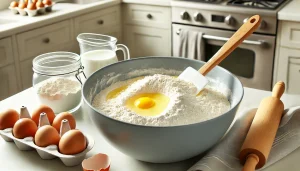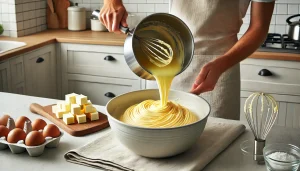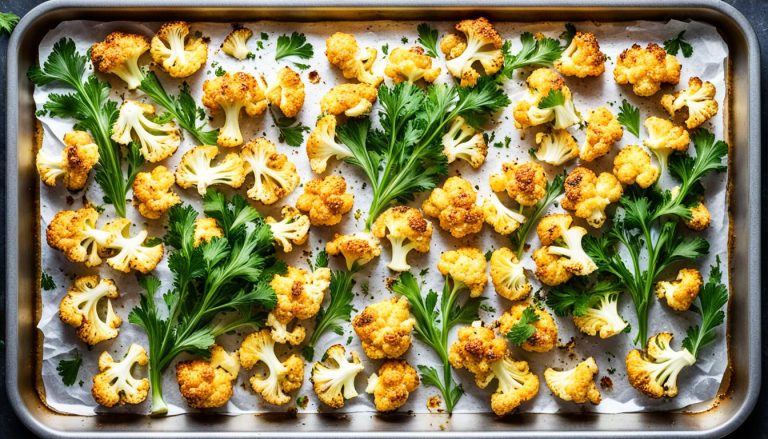Madeleines, the delicate and elegant shell-shaped pastries, are a quintessential treat in French baking. Often described as a cross between a cookie and a cake, these petite delights are perfect for afternoon tea or light dessert. With their soft, buttery interior and slightly crisp edges, Madeleines are as delicious as they are beautiful. In this blog, we’ll guide you through the Madeleine pastry recipe step by step, ensuring you can recreate this classic French delicacy in your own kitchen.
Madeleine Pastry Recipe
Madeleine Pastry Ingredients
To make the perfect Madeleines, you’ll need a few essential ingredients that you likely already have in your pantry. Here’s what you’ll need:
- 2/3 cup (85g) all-purpose flour
- 1/2 teaspoon baking powder
- 1/4 teaspoon salt
- 1/2 cup (115g) unsalted butter, melted and cooled
- 2 large eggs at room temperature
- 1/2 cup (100g) granulated sugar
- 1 teaspoon vanilla extract
- 1 teaspoon lemon zest (optional but recommended)
- Powdered sugar for dusting (optional)
These ingredients form the foundation of a classic Madeleine, but there are variations you can explore, which we’ll discuss later.
Madeleine Pastry Instructions
Step 1: Prepare the Batter
1. Melt the Butter: To begin, place a small saucepan over medium heat and melt the unsalted butter. Once melted, allow it to cool slightly. It’s important that the butter be cool when blended with the eggs later on.

2. Whisk the Dry Ingredients: In a medium bowl, whisk together the flour, baking powder, and salt. This step ensures that the leavening ingredient is equally distributed throughout the flour, essential to creating the iconic puff in Madeleines.

3. Beat the Eggs and Sugar: In a large mixing bowl, beat the eggs and granulated sugar together using a hand mixer or stand mixer. Beat on high speed for about 5 minutes or until the mixture is thick and pale and forms ribbons when the beaters are lifted. This step incorporates air into the batter, which helps create the light and fluffy texture of the Madeleines.

4. Add the Vanilla and Lemon Zest: Reduce the mixer speed to low and add the vanilla extract and lemon zest if using. The lemon zest adds a subtle citrusy aroma that complements the buttery richness of the Madeleines.

5. Fold in the Dry Ingredients: Gently fold the flour mixture into the egg mixture using a spatula. Do not overmix; you want to keep the airiness of the batter.

6. Incorporate the Butter: Slowly pour the melted butter into the batter, folding it in gently until thoroughly combined. The butter should be cool enough that it doesn’t deflate the batter.

Step 2: Chill the Batter
Chilling the batter is a crucial step in Madeleine’s making. Cover the bowl with plastic wrap and refrigerate for at least 1 hour, preferably overnight. Chilling allows the gluten to relax and the flavours to meld, resulting in a tender and flavorful pastry.
Step 3: Prepare the Madeleine Pan
While the batter chills, prepare your Madeleine pan. Grease the pan generously with butter or non-stick spray and dust with a light coating of flour. This will help the Madeleines release quickly and maintain their distinctive shell shape.
Step 4: Bake the Madeleines
1. Preheat the Oven: Preheat the oven to 375°F (190° C). Place a rack in the centre of the oven.
2. Fill the Moulds: Spoon the cold batter into the prepared Madeleine pan, filling each mould three-quarters full. Be cautious not to overfill the Madeleines, since they will puff up when baking.

3. Bake: Bake the Madeleines for 10-12 minutes, or until the edges turn golden brown and the centres spring back when softly pushed. The distinctive “hump” should form in the centre of each Madeleine

4. Cool and Dust with Sugar: Remove the pan from the oven and allow the Madeleines to cool in the pan for a few minutes. Then, gently remove them from the moulds and transfer them to a wire rack to cool completely. If desired, dust the Madeleines with powdered sugar before serving.

Nutrition Details
Madeleines are a treat best enjoyed in moderation. Here’s a general breakdown of the nutrition per serving (assuming 12 servings):
| Nutrient | Amount per Serving |
|---|---|
| Calories | 130 |
| Total Fat | 8g |
| Saturated Fat | 5g |
| Cholesterol | 45mg |
| Sodium | 65mg |
| Total Carbohydrates | 13g |
| Dietary Fiber | 0g |
| Sugars | 7g |
| Protein | 2g |
Preparation and Cooking Time
- Preparation Time: 20 minutes
- Chilling Time: 1 hour (minimum)
- Cooking Time: 10-12 minutes
- Total Time: Approximately 1 hour and 30 minutes
Madeleine Pastry Variations
While the classic Madeleines are delightful on their own, there are several variations you can try to add a twist to this traditional recipe:
- Chocolate Dipped Madeleines: Dip the cooled Madeleines halfway into melted dark or white chocolate. Let the chocolate set before serving.
- Almond Madeleines: Replace 1/4 cup of the flour with almond flour for a nutty flavour and slightly denser texture.
- Orange Blossom Madeleines: Add a teaspoon of orange blossom water to the batter for a fragrant and floral twist.
- Matcha Madeleines: Mix a tablespoon of matcha powder into the flour mixture for a vibrant green colour and a unique earthy flavour.
Other Famous Madeleine Variations
Paul Hollywood Madeleine Recipe
Instructions:
- Prepare the Batter: In a bowl, whisk 2 large eggs and 100g of caster sugar until pale and fluffy. Sift in 100g of plain flour and gently fold into the mixture.
- Add Butter: Melt 100g of unsalted butter and allow it to cool slightly. Fold the melted butter into the batter along with the zest of 1 lemon.
- Chill the Batter: Cover the batter and refrigerate for at least 1 hour.
- Preheat the Oven: Preheat your oven to 200°C (180°C fan) or 400°F. Grease and flour a madeleine tray.
- Bake the Madeleines: Spoon the batter into the madeleine tray, filling each mold about two-thirds full. Bake for 8-10 minutes until golden and risen.
- Cool: Remove the madeleines from the tray and cool on a wire rack. Dust with icing sugar before serving.
Difference: Paul Hollywood’s recipe emphasizes a classic preparation with lemon zest for a citrusy flavor and includes chilling the batter to help create the signature hump on the madeleines.
Madeleine Cake Recipe by Mary Berry

Instructions:
- Prepare the Batter: Beat 100g of softened butter and 100g of caster sugar together until light and fluffy. Add 2 large eggs, one at a time, beating well after each addition.
- Add Dry Ingredients: Sift in 100g of self-raising flour and gently fold it into the mixture along with 1 tablespoon of milk and the zest of 1 lemon.
- Preheat the Oven: Preheat your oven to 190°C (170°C fan) or 375°F. Grease and flour a madeleine tray.
- Bake the Madeleines: Spoon the batter into the madeleine tray, filling each mold about two-thirds full. Bake for 8-10 minutes until golden brown and risen.
- Cool: Remove the madeleines from the tray and cool on a wire rack. Dust with icing sugar before serving.
Difference: Mary Berry’s recipe uses self-raising flour, which simplifies the process by eliminating the need for a raising agent, and adds milk for a slightly richer texture.
Madeleine Recipe by Nigella
Instructions:
- Prepare the Batter: Whisk 2 large eggs and 100g of caster sugar until thick and pale. Sift in 100g of plain flour and fold into the mixture with 1 teaspoon of baking powder.
- Add Butter: Melt 100g of unsalted butter and allow it to cool. Fold the butter into the batter along with the zest of 1 orange and a splash of vanilla extract.
- Chill the Batter: Cover the batter and refrigerate for at least 1 hour.
- Preheat the Oven: Preheat your oven to 220°C (200°C fan) or 425°F. Grease and flour a madeleine tray.
- Bake the Madeleines: Spoon the batter into the madeleine tray, filling each mold about two-thirds full. Bake for 5-7 minutes until golden and slightly puffed.
- Cool: Remove the madeleines from the tray and cool on a wire rack. Dust with icing sugar or drizzle with melted chocolate before serving.
Difference: Nigella’s recipe includes orange zest and vanilla extract for a unique flavor twist, and uses a higher baking temperature for a quicker bake, resulting in a slightly crisper exterior.
Serving Suggestions
Madeleines are incredibly versatile and can be enjoyed in various ways, making them perfect for different occasions. Here are some ideas to elevate your Madeleine experience:
Classic Afternoon Tea
Serve Madeleines as part of a traditional afternoon tea spread. Pair them with a selection of fine teas, such as Earl Grey, Darjeeling, or Jasmine. The light, buttery flavour of Madeleines complements the aromatic notes of these teas, making them a delightful treat to enjoy alongside finger sandwiches, scones, and other pastries.
Elegant Dessert
Madeleines can be transformed into a sophisticated dessert by pairing them with a dollop of crème fraîche, whipped cream, or mascarpone cheese. Add a drizzle of honey or a sprinkle of powdered sugar for a touch of sweetness. For an extra indulgent twist, serve them with a small bowl of warm, melted chocolate or a fruit coulis for dipping.
Fruit and Madeleines

Fresh fruit pairs beautifully with the delicate flavour of Madeleines. Consider serving them with a side of fresh berries, such as raspberries, strawberries, or blueberries. The tartness of the berries contrasts nicely with the sweetness of the Madeleines, creating a balanced and refreshing treat.
Coffee and Madeleines
Madeleines are a perfect companion to a cup of freshly brewed coffee. Serve them with a latte, cappuccino, or espresso for an easy yet filling coffee break. The Madeleines’ buttery richness complements the coffee’s bold flavourse, making it a delightful pairing.
Special Occasions
For exceptional occasions, think about setting the Madeleines on a pretty tray or a tiered cake stand. Garnish with edible flowers or a dusting of powdered sugar for a visually stunning presentation. Madeleines make a beautiful and elegant addition to wedding receptions, bridal showers, or holiday gatherings.
French-Themed Brunch
Incorporate Madeleines into a French-themed brunch menu. Serve them alongside other French favourites like croissants, quiche, and baguettes. A light salad of mixed greens with a vinaigrette dressing and a selection of cheeses can complete the meal, offering a taste of France in your own home.
Conclusion
Madeleines are a timeless pastry that embodies the elegance and simplicity of French baking. With just a few simple ingredients and careful attention to detail, you can recreate these classic shell-shaped cakes in your kitchen. Whether you stick with the traditional recipe or experiment with variations, Madeleines are sure to become a favourite in your baking repertoire.
So, why not give this Madeleine pastry recipe a try? You’ll be rewarded with a batch of light, buttery, and utterly irresistible treats that are perfect for any occasion. Happy baking!
FAQ
What is the best way to store Madeleines?
Store Madeleines in an airtight container at room temperature for up to 2 days. For longer storage, freeze them and thaw them before serving.
Can I make Madeleines without a special pan?
While a Madeleine pan is recommended for the classic shape, you can use a mini muffin tin as a substitute, though the texture and appearance may vary.
Why do I need to chill the batter before baking?
Chilling the batter helps to relax the gluten and develop flavour, resulting in a tender texture and the characteristic hump in the Madeleines.
Can I make the batter ahead of time?
Yes, you can make the batter and refrigerate it for up to 24 hours before baking. This makes it convenient to bake fresh Madeleines when needed.
Why didn’t my Madeleines form a hump?
The hump typically forms when the batter is properly chilled, and the oven is preheated. Ensure both steps are followed for best results.
Can I flavour Madeleines with something other than lemon zest?
Absolutely! You can use orange zest, almond extract, or even a splash of liqueur to add different flavours to your Madeleines.
How do I prevent Madeleines from sticking to the pan?
Grease the pan well with butter or non-stick spray and dust with flour. This will help the Madeleines release easily and maintain their shape.

Madeleine Pastry Recipe
Ingredients
- 2/3 cup 85g all-purpose flour
- 1/2 teaspoon baking powder
- 1/4 teaspoon salt
- 1/2 cup 115g unsalted butter, melted and cooled
- 2 large eggs at room temperature
- 1/2 cup 100g granulated sugar
- 1 teaspoon vanilla extract
- 1 teaspoon lemon zest
Instructions
Prepare the Batter
- To begin, place a small saucepan over medium heat and melt the unsalted butter. Once melted, allow it to cool slightly.
- In a medium bowl, whisk together the flour, baking powder, and salt.
- In a large mixing bowl, beat the eggs and granulated sugar together using a hand mixer or stand mixer. Beat on high speed for about 5 minutes or until the mixture is thick and pale and forms ribbons when the beaters are lifted. This step incorporates air into the batter, which helps create the light and fluffy texture of the Madeleines.
- Reduce the mixer speed to low and add the vanilla extract and lemon zest if using. The lemon zest adds a subtle citrusy aroma that complements the buttery richness of the Madeleines.
- Gently fold the flour mixture into the egg mixture using a spatula.
- Slowly pour the melted butter into the batter, folding it in gently until thoroughly combined. The butter should be cool enough that it doesn't deflate the batter.
Chill the Batter
- Cover the bowl with plastic wrap and refrigerate for at least 1 hour, preferably overnight.
Prepare the Madeleine Pan
- While the batter chills, prepare your Madeleine pan. Grease the pan generously with butter or non-stick spray and dust with a light coating of flour.
Bake the Madeleines
- Preheat the oven to 375°F (190° C). Place a rack in the centre of the oven.
- Spoon the cold batter into the prepared Madeleine pan, filling each mould three-quarters full. Be cautious not to overfill the Madeleines, since they will puff up when baking.
- Bake the Madeleines for 10-12 minutes, or until the edges turn golden brown and the centres spring back when softly pushed. The distinctive "hump" should form in the centre of each Madeleine
- Remove the pan from the oven and allow the Madeleines to cool in the pan for a few minutes. Then, gently remove them from the moulds and transfer them to a wire rack to cool completely. If desired, dust the Madeleines with powdered sugar before serving.









